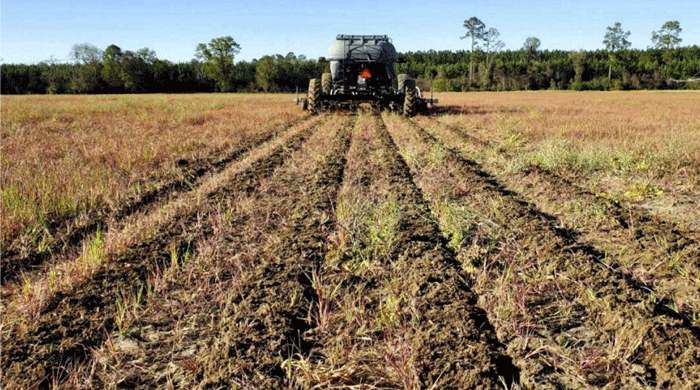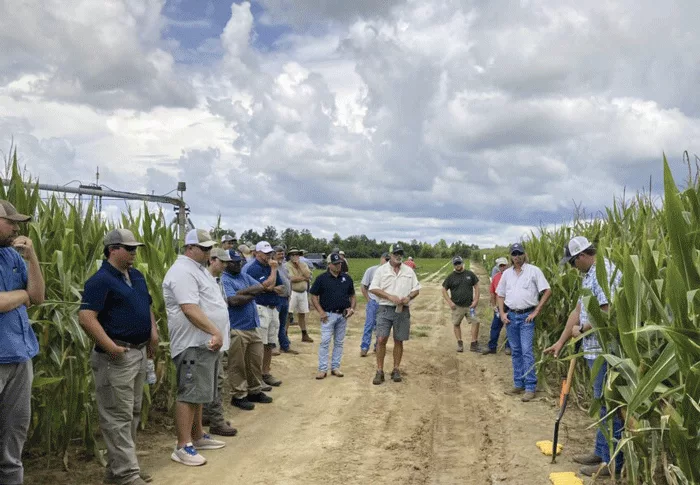Caleb Traugh, of Blakely, Ga., isn’t your typical strip-tiller. He didn’t grow up on a farm. He doesn’t have an ag degree, and he didn’t go to college.
But the 26-year-old has been obsessed with the science behind soils and plants for as long as he can remember.
“When you bleed green and always have dirt under your fingernails, there’s plenty of opportunity in agriculture,” Traugh says.
He first tapped into his passion for agriculture as a 3-year-old picking cotton on his friend’s farm. At 10, he experimented with cover crop blends in his family garden. At 12, he wrote a letter to Martha Stewart in response to an article in her magazine containing faulty descriptions of the bacterial decomposition process during composting.
“She wrote back acknowledging the error, saying the article was written for ‘amateurs,’” Traugh recalls.
After a short stint in the wildlife industry, Traugh launched his own crop consulting business in 2020. Although he lacks a traditional resume, Traugh didn’t need much time to establish credibility. He placed second in the 2021 National Corn Growers Association (NCGA) Georgia Corn Yield Contest with just over 270 bushels per acre in the strip-till, minimum-till, mulch-till, ridge-till, irrigated class.
“I’ve been fortunate to learn from ag professionals who are at the top of their game,” Traugh says. “And the field is certainly the best classroom. My willingness to always try something new has led us to adopt different farming methods like strip-till and banded fertilizer.”
Mad Scientist
Traugh grows a combination of corn, peanuts, cotton, oats and soybeans in the southwest corner of Georgia.
“Who doesn’t like to push for high yields?” Traugh says, but his main focus is on research. He treats most of his acres like a science lab, conducting upwards of 200 research trials each year. Traugh reveals his findings during an annual field day event in the summer.
“It’s something that I really look forward to hosting,” he says. “I try not to be like the growers who learn something and just keep it to themselves — that’s not me. I want to share it and use the information to help others.”
“What if we keep 2-3 things the same, and change everything else?"
Perhaps Traugh is so eager to give back because others did the same for him. He learned about strip-till from podcast interviews and picked up tips from experienced strip-tillers willing to share their playbooks.
“That was huge for me, especially living in an area where there aren’t a lot of strip-tillers,” Traugh says. “We had to travel pretty far to learn from growers who had strip-till programs in place. But when we started doing it, we still had to learn on our own — things like equipment setup and finding the right quality of fertilizer were big challenges.”
Complete Fertility Package
Strip-till helps Traugh deal with the difficulties of farming in a hot, dry climate on low cation exchange capacity (CEC) soils that he describes as “highly weathered, very acidic and not very fertile.” But the biggest benefit of strip-till is the boost it gives to his bottom line.
“It’s easy to outspend your budget with fertilizer prices as high as they are today,” Traugh says. “Instead of focusing on building up our entire soil profile just to get things balanced for the plant, we really focus on keeping the root zone balanced and high in fertility.”
Traugh makes strips in the spring ahead of corn after terminating cover crops or harvesting small grains. He runs a KMC Rip/Strip with a Montag fertilizer cart attached, applying a homogenized fertilizer mix containing nitrogen (N), potassium (K), phosphorous (P), calcium, magnesium, sulfur, born, manganese and zinc at variable rates based on yield goals within management zones.
“When we first started, we were just applying 1-2 different products with our strip-till pass,” Traugh says. “But we really took things to the next level when we built this complete fertility package — containing not just NPK, but also secondary and micronutrients to make sure the crop has what it needs to reach its full potential.”

NUTRIENT MICROMANAGEMENT. Caleb Traugh builds strips in the spring with a KMC Rip/Strip, and applies micronutrients like calcium, magnesium, sulfur, boron, manganese and zinc. “When we pull soil samples from high-yielding fields, we’ll see a drop in micronutrient levels,” Traugh says. “It’s important to include micronutrients in addition to NPK to push through the yield boundaries that were holding us back.” Photo by: Caleb Traugh
The shank on Traugh’s strip-till unit runs 12-14 inches deep. He initially placed his fertilizer about 6-8 inches down the trench but started running into problems after heavy downpours in the spring.
“We pulled soil samples every 1-2 inches and discovered that our fertilizer had fallen down to the bottom of that trench,” Traugh says. “Now, we’re trying dual placement. We apply some fertilizer 6-8 inches deep and also some on top of the ground behind our shank. Then we’re using the coulters behind the shank to mix up a band of fertility that’s in the top 3-4 inches, which will hopefully solve some of the issues we’ve been running into.”
Cover Crop & Strip-Till Harmony
Traugh plants cover crops on most of his strip-till acres to protect his soil from heavy rains over the winter.
“Our ground doesn’t freeze in the winter down here,” Traugh says. “Before we started using cover crops, we’d need go out for 1-2 weeks with a dirt pan every spring just to put our dirt back in the fields. Cover crops have minimized erosion and are keeping nutrients in the field from the previous growing season.”
Traugh has experimented with planting up to 13 species in a field, but he says 2-3 species is the sweet spot, with cereal rye and oats being the most consistent.
“One of the first years we used cover crops, I planted 6 different species,” Traugh says. “I didn’t have a good handle on the rates and applied about 2-3 times more than I should’ve. It presented a challenge for our strip-till equipment, and we had to make big adjustments to handle the cover crops. Now with the adjustments, even if it’s a waist high cover crop that we just terminated, we’re able to make a nice consistent bed to give us a good foundation for our crops.”
He usually terminates cover crops before making strips. He tries planting green in some fields but has often struggled with pests and disease when doing so.
Whether it’s new cover crop mixes, equipment adjustments or fertilizer placement, Traugh is constantly looking for the next big thing in strip-till.
“One of my good friends said, ‘Caleb, you should take 2-3 things and change them every year on your operation.’ I said, ‘What if we take 2-3 things, keep them the same and change everything else?’
“I’m always trying to figure out how to overcome limitations or fix the issues we’re facing, because we only have one chance a year to farm. I try to speed up my learning curve. That’s why we spend a lot of our time on research and small-scale plots so we can learn as quickly as possible.”






